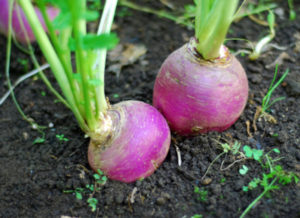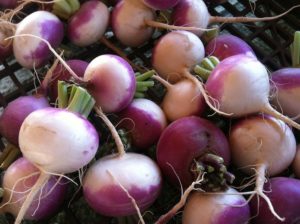General information:-
It is hardy cool weather crop belongs to family of Brassicaceae. It is grown for its roots as well as for green leaves. Turnip root is rich source of Vitamin C where as its leaves are rich source of Vitamin A, Vitamin C, Vitamin K, foliate and Calcium. It is grown in temperate, tropical as well as sub-tropical region of India. Commonly grown turnip is of white color. Bihar, Punjab, Haryana, Himachal Pradesh and Tamil Nadu are major turnip growing states in India.
Climate:-
Season
Temperature
12-30°C
Season
Rainfall
200-400cm
Season
Sowing Temperature
18-23°C
Season
Harvesting Temperature
10-15°C
Soil:-
It can be grown on variety of soil but turnip give best result when grown on loamy soils rich in organic matter. Avoid heavy or compact soils also very light soils as it produce rough, malformed roots. Ideal pH of soil for good growth is 5.5 to 6.8.
Popular varieties with yield:-
Punjab Safed 4: Recommended for cultivation in Punjab and Haryana. Its roots are pure white, round and medium sized with mild taste.
Other State variety
Pusa Kanchan
Pusa Sweti
Pusa Chandrima
Purple top white globe
Golden Ball
Snowball
Pusa Swarnima
Land preparation:-
Plough land thoroughly and make land weed and clods free. Add well decomposed cow dung of 60-80 qtl/acre and mix well in soils at the time of land preparation. Avoid use of undecomposed or free cowdung as it will leads to forking of fleshy roots.
Sowing:-
Time of sowing
August-September is best time for sowing desi varieties whereas October-November month is ideal for European varieties.
Spacing
Use row to row spacing of 45 cm and plant to plant spacing of 7.5 cm.
Sowing Depth
Sow seeds at depth of 1.5 cm.
Method of Sowing
Direct sowing on bed, in lines or on ridge.
Seed:-
Seed Rate
For sowing of one acre land seed rate of 2-3 kg is sufficient.
Seed treatment
Before sowing treat seed with Thiram@3gm per kg of seeds to protect crop from crown rot
Ferrtilizer:-
Fertilizer Requirement (kg/acre)
UREA SSP MURIATE OF POTASH
55 75 #
Nutrient Requirement (kg/acre)
NITROGEN PHOSPHORUS POTASH
25 12 #
Amount of fertilizer to be applied is vary from place to place as it depend upon various factor like climate, soil type, fertility status etc.
Along with well decomposed cowdung, apply Nitrogen@25 kg (in the form of Urea@55 kg), Phosphorus@12 kg (in the form of SSP@ 75 kg/acre) per acre in soil at time of sowing.
Weed control:-
10-15 days after germination, carry out thinning operation. Take interculture operation like weeding and hoeing to keep check on weed growth also to provide soil aeration. Take one weeding operation, two to three weeks after sowing. After weeding, carryout earthing operation
Irrigation:-
After sowing, apply first irrigation, it will help in good germination. Depending upon soil type and climate, apply remaining irrigations at the interval of 6-7 days in summer and 10-12 days interval in winter month. Overall turnip required five to six irrigations. Avoid excessive irrigation as it will leads ugly shape of roots and numerous hair growth.
Plant protection:-
Crown rot
 Disease and their control:-
Disease and their control:-
Crown rot: As a preventive measure, before sowing treat seed with Thiram@3 gm per kg of seeds. 7th and 15th day after sowing, drenched soil around seedlings with Captan@200 gm in 100 ltrs water.
Harvesting:-
Depending upon variety uproot turnip roots after attaining marketable size i.e. when they are 5-10 cm in diameter. Generally roots are reached to marketable size in 45-60 days i.e. depending upon variety after sowing. Delay in harvesting will leads to tough and fibrous root formation. Carry out harvesting in evening time. After harvesting, roots along with green tops are washed with water. They are filled into the basket and then sent to market. Under cool and moist condition, roots can be stored for 2-3 days where as they can store for 8-15 week at 0-5 °C temperature with 90-95% relative humidity.
Seed production:-
For seed purpose, sow seeds of turnip in mid-September and then transplant seedling in first week of December. Use spacing of 45 cm x15 cm. Apply N@30 kg (in form of Urea@65 kg) and P@8 kg (in form of SSP@50 kg) per acre. At time of sowing apply whole amount of Phosphorus and half amount of Nitrogen. Apply remaining amount of Nitrogen, 30 days after sowing. Carry out harvesting when 70% pods changes its color to light yellow.
Referenes:-
1.Punjab Agricultural University Ludhiana
2.Department of Agriculture
3.Indian Agricultural Research Instittute, New Delhi
4.Indian Institute of Wheat and Barley Research
5.Ministry of Agriculture & Farmers Welfare
